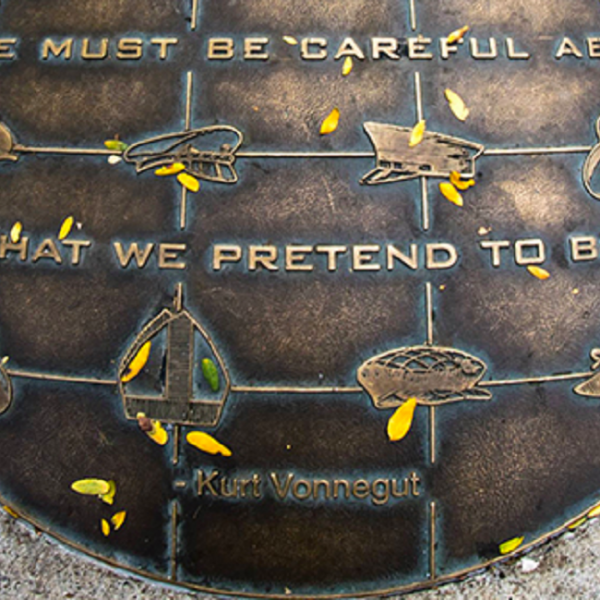John Sutherland on Kurt Vonnegut
Some authors create from scratch, imagining situations and characters to fill their pages; others live and write their realities. In John Sutherland’s playfully encyclopedic Lives of the Novelists: A History of Fiction in 294 Lives, he works to catalog the methods and experiences of 294 notable writers. In this passage, Sutherland digs into Kurt Vonnegut’s famous and disturbing Slaughterhouse-Five, noting the influence of Vonnegut’s time as a solider on his writing.
John Sutherland—
On the night of 13 February 1945, three months before the end of the Second World War, Kurt Vonnegut was a POW sheltering in an underground animal slaughterhouse during the devastating fire-bombing of Dresden. Slaughterhouse Five (Schlachthof Fünf) was the shelter from the slaughter. ‘We got through it’ Vonnegut wryly recalled, ‘because we were quartered in the stockyards where it was wide and open and there was a meat locker three stories beneath the surface, the only decent shelter in the city. So we went down into the meat locker, and when we came up again the city was gone and everybody was dead. We walked for miles before we saw anybody else: all organic things were consumed.’ Vonnegut and his fellow American POWs, exhumed at dawn from their underground coffin, were set to work ‘corpse mining’ – excavating blackened bodies for a second cremation on open piles. The live meat took care of the dead meat.
Vonnegut survived the slaughter to write Slaughterhouse-Five (1969). Thousands didn’t survive. In the novel, Billy Pilgrim, the unheroic hero, is a POW in the same shelter as Vonnegut during the devastating fire-bombing. He too survives – but he goes crazy. Vonnegut published many personal accounts of his Dresden experience – as well as that in Slaughterhouse-Five. The following is from an interview in 1974. ‘I was present in the greatest massacre in European history, which was the destruction of Dresden by fire-bombing … The American and British air forces together killed 135,000 people in two hours. This is a world’s record. It’s never been done faster, not in the Battle of Britain or Hiroshima. (In order to qualify as a massacre you have to kill real fast). But I was there, and there was no news about it in the American papers, it was so embarrassing.’ RAF estimates later downscaled the civilian casualties to a ‘mere’ 35,000. But Vonnegut’s point stands. Fiction, like history, has been generally silent about Dresden. Victors, as Hitler said, write history.
They also forget the embarrassing bits. Vonnegut himself had almost insuperable personal difficulties writing his ‘Dresden novel’. He had to forge an entirely new ‘schizophrenic’ technique, weaving realism, SF schlock (little one-eyed green men from Tralfamadore, resembling toilet plungers), and slapstick social comedy into a startlingly innovative pattern.
The thesis of Slaughterhouse-Five is T. S. Eliot’s – mankind cannot bear too much reality. Life is so horrible, that only fiction can deal with it – and, crucially, the more horrible the life experience, the more fantastic (unrealistic) the fiction. After Auschwitz, Theodor Adorno famously declared, poetry was impossible. One of the underlying contentions of Slaughterhouse-Five is that after Dresden, fiction (specifically ‘War and Peace’ fiction of the old Tolstoyan kind) is impossible. A way out of the impasse was science fiction. Billy Pilgrim, a time and intergalactic traveller (or, more likely, merely nuts) ends his post-Dresden pilgrimage incarcerated no longer by Nazi Germany but by aliens from the planet Tralfamadore, some 446,120,000,000,000,000 miles from earth, whither he has been transported by flying saucer (widely believed in during the 1960s).
… Interestingly, Vonnegut himself did not call Slaughterhouse- Five a ‘novel’ but, more awkwardly, ‘my Dresden book’. Billy Pilgrim is not Vonnegut,but a fellow POW called Joe Crone who did not survive the war. Crone was, like Billy, comically malcoordinated, a soldier doomed always to be the platoon klutz. Helet himself starve to death before the firestorm and is ‘buried somewhere in Dresden,wearing a white paper suit’. Vonnegut resurrected him.
Vonnegut did not, in the conventional sense, write Slaughterhouse-Five – it rose out of his subconscious like a slow bruise. Immediately after the war he found he could not remember the event: ‘There was a complete blank where the bombing of Dresden took place … And I looked up several of my war buddies and they didn’t remember either.”…
Excerpted from Lives of the Novelists.Copyright © 2011 by John Sutherland. All rights reserved.






Vonnegut’s zany and surreal world reflects the absurdity of our own and really bent my mind to different modes of thinking. His work has inspired my own visual arts for quite some time and I created a tribute illustration of the author with the help of an old typewriter. You can see it at http://dregstudiosart.blogspot.com/2011/11/happy-birthday-mr-vonnegut.html and tell me how his work and words also affected you.